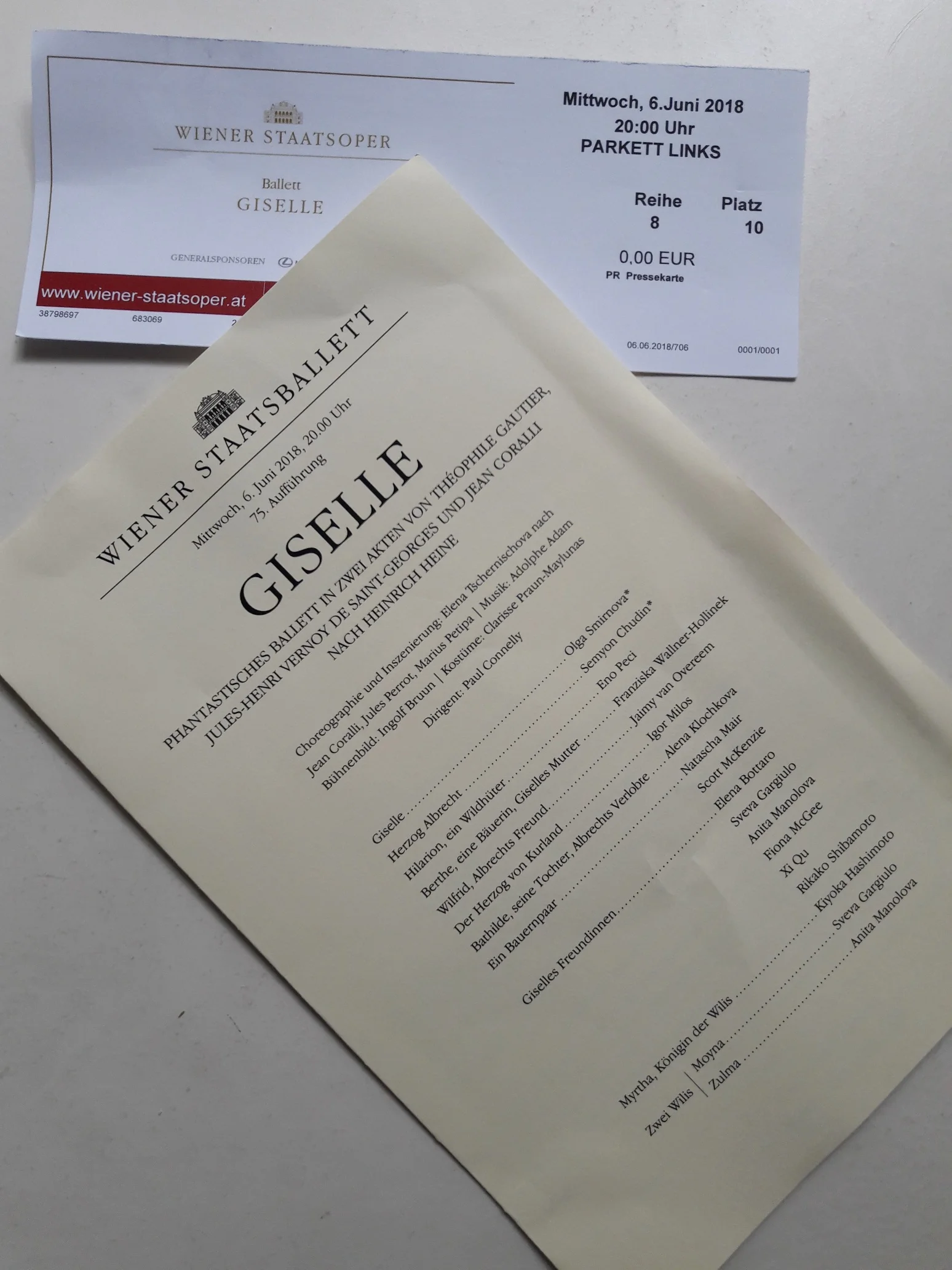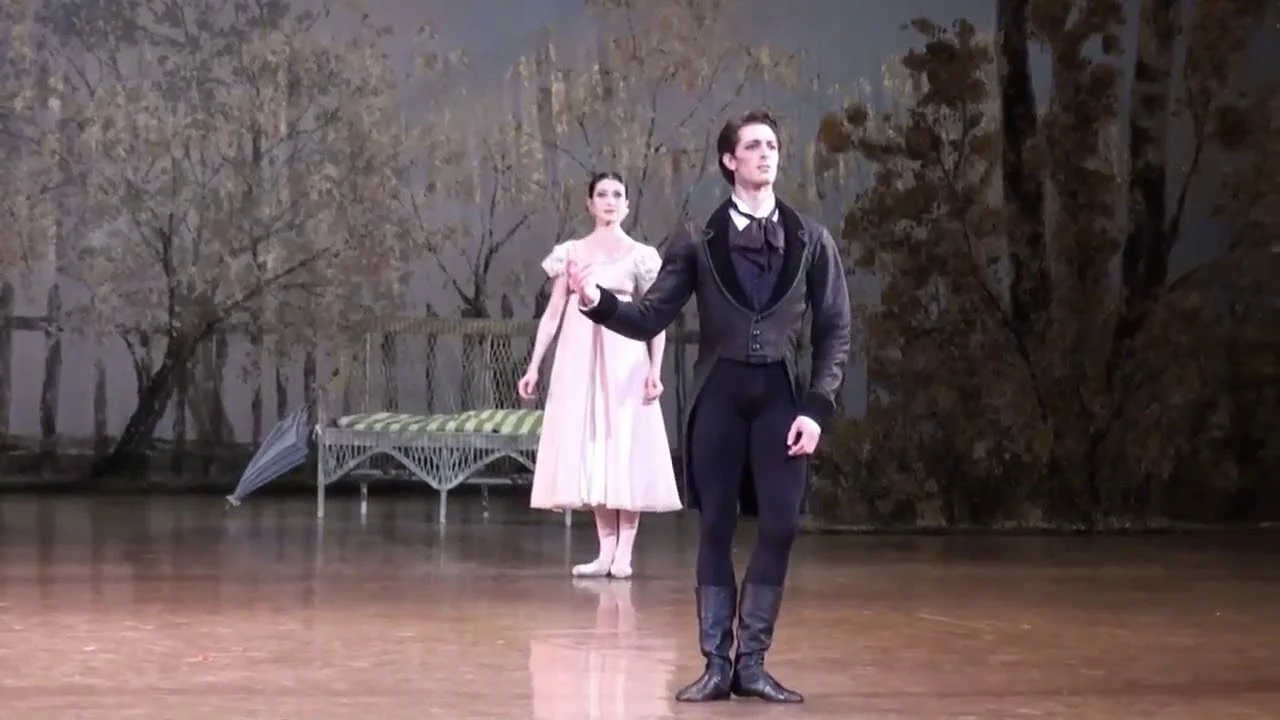Giselle - revisited - Vienna State Ballett, June 6th, 2018
The first word that ocurred to me, while thinking about yesterday's performance was "Purism". Yes. Dance like it should be. Dance for the sake of Dance - and nothing else.
I have the funny feeling that this review is not going to be a long one… It would seem like a blasphemy to try to put in words what we have experienced last night. Does this sound strange to you? I have just looked up the real meaning of the word “blasphemy” and it suits like a perfect glove to what I want to express. Blasphemy: irreverence toward something considered sacred or inviolable. Yes, I see both Olga Smirnova and Semyon Chudin as „sorcerers“ in this beautiful „temple“ called Art. Divine Figures of Ballet.
Before we come to them – in the most simple and uncomplicated way of seeing things - purism – we’ll mention some notable details of yesterday’s cast.
Elena Tschernichova’s version of “Giselle” is not one of my favourites. With all my respect to the late Miss Tschernichova, I also “question” very strongly what the precise definition of the word “version” really is ( version: A particular form of something differing in certain respects from an earlier form or other forms of the same type of thing??? ). But if the “body” of the choreography is still the same what is really the point of making changes “here and there” in order to have another “version”? For instance, one very long awaited moment in the Ballet World is Myrtha’s first entrance. Technically tricky, exhausting, a challenge in which the dancer can really be on the spotlight. But in this version it is disappointing, dull and boring. It does not leave a “footstep” on your mind.
Copyright: Vienna State Ballet / Ashley Taylor
I must mention the very well-rehearsed Corps-de-Ballet. “Little things” like having all Willis moving forward in an arabesque while the supporting leg is slightly bent in a plié may appear to be an easy thing to do – but they are definitely not! The leg (on the air) cannot, should not move (and my eyes are extremely meticulous to that!). The girls yesterday were a pure delight. Insight & discipline... even when wearing those costumes by Clarisse Praun-Maylunas that “rob” so much of the Ballet’s original romanticism. Chapeau!
I go on and wish to comment on names that always make sure that the supporting cast is one that you can rely on: Jaimy van Overeem, Igor Milos and, the incomparable, Franziska Wallner-Hollinek as Berthe. She nearly broke my heart. A great actress with an impressive charisma. We are going to miss her presence on stage - she is retiring at the end of the Season. I take this opportunity to thank her for all she has given to us during all these years and wish her all the best for her future life!
Copyright: Vienna State Ballet / Ashley Taylor
The peasant pas de deux was joyfully (and very precisely) danced by enchanting Natascha Mair and “newcomer” Scott McKenzie. This young gentleman has developed himself so much during the past year and I am most impressed. Stage presence, musicality, very (extremely in fact) clean technique. To add to all these qualities, he also has a beautiful physique and a very charming manner that will conquer audiences. Miss Mair, a “darling” of Viennese audiences and a dancer whose dedicated career I have been following for many years, gave a very well-defined interpretation in a pas de deux that has no “story”, in fact, to tell. Looking at her just beside Olga Smirnova I thought: “one day she might give also a beautiful Gis… “, oh, it is just a thought.
Sveva Gargiulo and Anita Manolova, gave very confident portrayals of Moyna and Zulma, in fact two “supporting characters” that have the difficult task to be sometimes in the background but carry the plot – and technically speaking – not in the easiest of ways.
Copyright: Vienna State Ballet / Ashley Taylor
Eno Peçi and his experience. Eno Peçi and his unique way of projecting emotions up to the galleries. Eno Peçi. His Hilarion is not only an angry, jealous character. There is no “imitation” of feelings. There is but an explosion of feelings coming from a hot-blooded man. From a person really made of flesh and blood. This Japanese Lady sitting just beside me said, during the bows: “He is my favourite!”
Kiyoka Hashimoto’s Myrtha: even not having the most impressive piece of choreography for her entrance (Does anyone still remember who danced Myrtha at the première in 1993? I just remember Birgit Stadler as Giselle and Vladimir Mahlakoff as Albrecht… and I seem to have lost this particular programme... may this be the reason why this entrance is so "facilitated"?), she gave, technically a good Myrtha. Strong jumps, very clean, resolute and quite determined but there was a certain lack of the Queen of the Willi’s sadness and bitterness, that certain frustration of having died an old maiden, an “elderly” virgin. That "key point" to this role. I missed that strongly.
Copyright: Vienna State Ballet / Ashley Taylor
Semyon Chudin’s Albrecht and Olga Smirnova’s Giselle were played with a certain “low-profile” that I much admire. There was no necessity – especially for her in the “mad scene” – to exaggerate in order to make the audience concentrate more in the acting than in the technique, distracting the public from certain technical flaws (the second act’s pas de deux and coda are very demanding). They were in complete control, not only emotionally but also technically, of what they were doing and looking human, normal, fragile and vulnerable. Not like “technique Gods” but "just like" "Masters of their own Artistry".
Copyright: Vienna State Ballet / Michael Pöhn
From the beginning on it was obvious that Mr. Chudin’s Albrecht would not be a “romantic hero” (like Baryshnikov’s was in the beginning of his career) but a cynical playboy (also like Baryshnikov’s was towards the end of his career) with a certain poise and confidence of the “upper crust” which makes it very easy for him to “play” with Giselle. This confidence and preposterous and arrogant ways were also showed on his jumps, pirouettes, Tours en l’air and his endless entre-chats (marcelous by the way) from the second act. Great poise and posture as "Albrecht". And I am not only referring to the physical side. Great work!
Copyright: Vienna State Ballet/ Ashley Taylor
Miss Smirnova’s Giselle is, as I said before, quite “low profiled” and so touching, especially because of that. Even in this low-keyed interpretation she is able to project her “spirit” (well, she is one that just came back from “six feet under” in the second act, isn't she?) through the whole Opera House. The pas de deux in the second act was sublime even though the adagio was conducted too quickly by Paul Connelly. Also the batteries were conducted too slowly and that is very difficult for the performer, especially in a moment in which the “connoisseurs, les balletomanes” sit very erectly in order to pay special attention to what is being developed on stage, her feet in fact.
I realized, by the end of the show, that somehow this kind of low-keyed interpretation is quite unusual for Viennese audiences. A big part of the public stood up, willing to go out but the curtain-calls were not yet finished, not remotely – because another part of the public was static with joy. Really cheering! Two different worlds...
There is lots to talk about, discuss, philosophize and figure out about interpretation forms. And that is the fascinating point about Art: There is, Thank God, everyday lots of new "stuff" to learn.
Copyright: Vienna State Ballet / Ashley Taylor
I honestly thought that this review was going to be somewhat short… It should be a reverence to those Artist’s great performances that made me remember so much a “kind of Giselle” I had seen last with Baryshnikov (as a cynical Albrecht) and “low-keyed” Royal’s Antoinette Sibley.
A reverence… and I hope that in some small way I just did that to Miss Smirnova and Mr. Chudin!
And to Monsieur Manuel Legris for bringing such wonderful Artists to Vienna!
Video by Tamara Pavlova and published with her kind consent. Many thanks.












